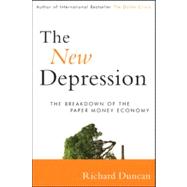
Note: Supplemental materials are not guaranteed with Rental or Used book purchases.
Purchase Benefits
What is included with this book?
CHAPTER 1 How Credit Slipped Its Leash 1
Opening Pandora’s Box 1
Constraints on the Fed and on Paper Money Creation 3
Fractional Reserve Banking Run Amok 5
Fractional Reserve Banking 5
Commercial Banks 7
The Broader Credit Market: Too Many Lenders, Not Enough Reserves 10
Credit without Reserves 12
The Flow of Funds 13
The Rest of the World 15
Notes 15
CHAPTER 2 The Global Money Glut 17
The Financial Account 18
How It Works 20
What Percentage of Total Foreign Exchange Reserves Are Dollars? 23
What to Do with So Many Dollars? 24
What about the Remaining $2.8 Trillion? 26
Debunking the Global Savings Glut Theory 28
Will China Dump Its Dollars? 31
Notes 32
CHAPTER 3 Creditopia 33
Who Borrowed the Money? 33
Impact on the Economy 38
Net Worth 39
Profits 41
Tax Revenue 41
Different, Not Just More 41
Impact on Capital 45
Conclusion 49
Note 49
CHAPTER 4 The Quantity Theory of Credit 51
The Quantity Theory of Money 52
The Rise and Fall of Monetarism 55
The Quantity Theory of Credit 57
Credit and Inflation 59
Conclusion 60
Notes 61
CHAPTER 5 The Policy Response: Perpetuating the Boom 63
The Credit Cycle 64
How Have They Done so Far? 65
Monetary Omnipotence and the Limits Thereof 66
The Balance Sheet of the Federal Reserve 67
Quantitative Easing: Round One 69
What Did QE1 Accomplish? 71
Quantitative Easing: Round Two 72
Monetizing the Debt 73
The Role of the Trade Deficit 75
Diminishing Returns 76
The Other Money Makers 78
Notes 83
CHAPTER 6 Where Are We Now? 85
How Bad so Far? 85
Credit Growth Drove Economic Growth 86
So, Where Does that Leave Us? 88
Why Can’t TCMD Grow? 89
The Banking Industry: Why Still Too Big to Fail? 96
Global Imbalances: Still Unresolved 101
Vision and Leadership Are Still Lacking 104
Notes 105
CHAPTER 7 How It Plays Out 107
The Business Cycle 107
Debt: Public and Private 109
2011: The Starting Point 111
2012: Expect QE3 112
Impact on Asset Prices 114
2013–2014: Three Scenarios 114
Impact on Asset Prices 118
Conclusion 119
Notes 120
CHAPTER 8 Disaster Scenarios 121
The Last Great Depression 121
And This Time? 126
Banking Crisis 126
Protectionism 127
Geopolitical Consequences 128
Conclusion 132
Note 132
CHAPTER 9 The Policy Options 133
Capitalism and the Laissez-Faire Method 134
The State of Government Finances 140
The Government’s Options 142
American Solar 143
Conclusion 146
Notes 147
CHAPTER 10 Fire and Ice, Inflation and Deflation 149
Fire 150
Ice 151
Fisher’s Theory of Debt-Deflation 152
Winners and Losers 155
Ice Storm 157
Fire Storm 157
Wealth Preservation through Diversification 158
Other Observations Concerning Asset Prices in the Age of Paper Money 160
Protectionism and Inflation 165
Consequences of Regulating Derivatives 166
Conclusion 166
Notes 167
Conclusion 169
About the Author 171
Index 173
The New copy of this book will include any supplemental materials advertised. Please check the title of the book to determine if it should include any access cards, study guides, lab manuals, CDs, etc.
The Used, Rental and eBook copies of this book are not guaranteed to include any supplemental materials. Typically, only the book itself is included. This is true even if the title states it includes any access cards, study guides, lab manuals, CDs, etc.